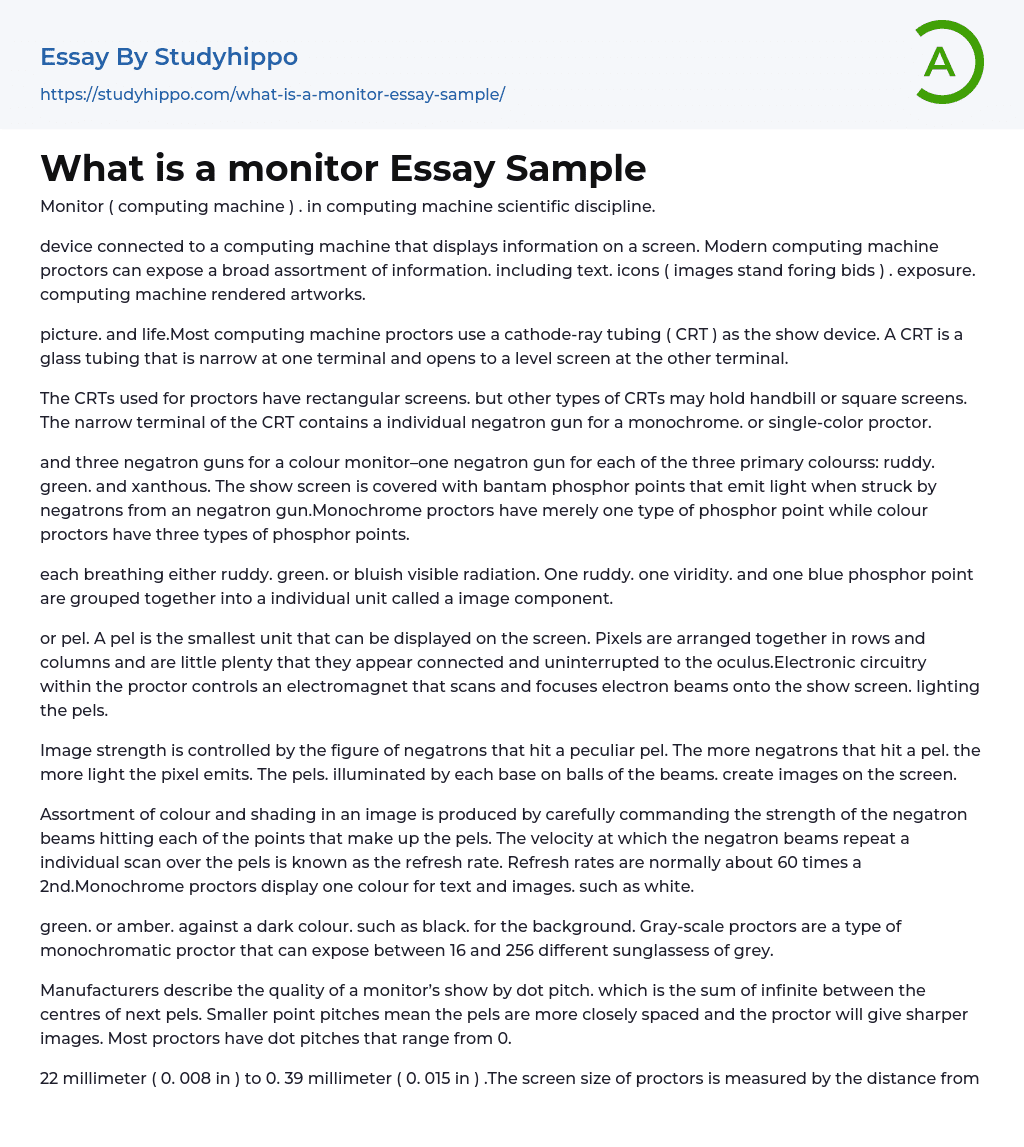In computer science, a computing machine is often referred to as a monitor.
A display is a device that connects to a computer and presents a wide range of information on a screen, such as text, icons (images representing commands), photos, and computer-generated artwork.
Computing machine monitors typically utilize a cathode-ray tube (CRT) as their display device, which is a glass tube that tapers to one end and opens up to a flat screen at the other. This technology is commonly used for displaying pictures and other visual content.
While the CRTs used for proctors possess rectangular screens, other varieties of CRTs might feature square screens or be suitable for displaying handbills. Moreover, the slender terminal of such CRTs consists of a solitary electron gun, which is solely meant for a monochrome or single-color proctor.
Color moni
...tors use three negatron guns, one for each primary color (red, green, and yellow), while monochrome monitors only use one type of phosphor point.
The display screen consists of small phosphor points that emit light when struck by negatrons from a negatron gun.
Visible light is comprised of three distinct colors: red, green, and blue, each with its own corresponding phosphor point. When these three phosphor points are combined into a single unit called an image component, they create a complete color image.
A pel, also known as a pixel, is the tiniest unit of display on a screen. When arranged in rows and columns, pixels appear connected and uninterrupted to the viewer, and the electronic circuitry within the monitor controls an electromagnet that scans and focuses electron beams onto the display screen, thereby illuminating the pixels.
The emission of light
from a pixel is determined by the quantity of electrons that strike it. A greater number of electrons results in a more intense brightness. As each beam passes, it illuminates the pixels, which then form the images displayed on the screen.
Controlling the strength of negatron beams hitting individual pel points creates a range of colors and shading in images. The refresh rate, which is the speed at which negatron beams repeat scans over pels, is typically 60 times per second. Monochrome monitors display only one color, such as white, for both text and images.
Green or amber are suitable options when set against a dark background, such as black. Gray-scale proctors belong to the group of monochromatic proctors and have the ability to display anywhere between 16 to 256 variations of different shades of grey.
The quality of a monitor's display is defined by dot pitch, which is calculated by the distance between the centers of adjacent pixels. A smaller dot pitch indicates that the pixels are closely spaced and produces sharper images. Typically, monitors have dot pitches within the range of 0.
The typical measurement of projector screen size is the distance between opposite corners, usually around 38 centimeters (15 inches). The width of the display varies from as little as 22 millimeters (0.008 inches) to a maximum of 0.39 millimeters (0.015 inches).
The size of proctors varies from 22.9 centimeters (9 inches) to 53 centimeters (21 inches), with landscape proctors being wider than they are tall and considered standard, while portrayal proctors have greater height than breadth. The total number of items is unknown.
The information that a proctor can display is dependent on varying
factors such as screen size, point pitch, and type of show arranger utilized. The show arranger receives data in a formatted manner from the computer and then displays the information on the screen for the user to view.
Arrangers for displaying content must adhere to various regulations that determine the amount of resolution they can support. The majority of color monitors are designed to conform to the Video Graphics Array (VGA) standards, which dictate a resolution of 640 by 480 pixels (640 pixels per row across 480 rows), or approximately 300,000 pixels.
VGA produces 16 colors, which is now considered low compared to modern monitors with higher resolutions. SVGA monitors have 1024 by 768 pixels, or approximately 800,000, and can display over 60,000 different colors.
SVGA monitors have the ability to display over 16 million colors, distinguishing them as a type of computer display characterized by a CRT screen. Alternative types of displays include flat screens utilized in laptops, commonly employing liquid-crystal displays (LCDs) and other thin screens.
Currently, there are ongoing developments of proctors with flat screens, which avoid the use of CRTs.
- Smartphone essays
- Cell Phones essays
- Camera essays
- Computer essays
- Ipod essays
- Mobile Phones essays
- 3g essays
- Bluetooth essays
- Cell Phones in School essays
- Computer File essays
- Desktop Computer essays
- Servers essays
- Incandescent Light Bulb essays
- John Locke essays
- 9/11 essays
- A Good Teacher essays
- A Healthy Diet essays
- A Modest Proposal essays
- A&P essays
- Academic Achievement essays
- Achievement essays
- Achieving goals essays
- Admission essays
- Advantages And Disadvantages Of Internet essays
- Alcoholic drinks essays
- Ammonia essays
- Analytical essays
- Ancient Olympic Games essays
- APA essays
- Arabian Peninsula essays
- Argument essays
- Argumentative essays
- Art essays
- Atlantic Ocean essays
- Auto-ethnography essays
- Autobiography essays
- Ballad essays
- Batman essays
- Binge Eating essays
- Black Power Movement essays
- Blogger essays
- Body Mass Index essays
- Book I Want a Wife essays
- Boycott essays
- Breastfeeding essays
- Bulimia Nervosa essays
- Business essays
- Business Process essays
- Canterbury essays
- Carbonate essays




